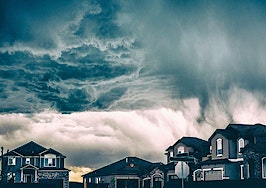Join industry visionaries Pete Flint, Spencer Rascoff, Ryan Serhant and more at Inman Connect New York, Jan. 24-26. Punch your ticket to the future by joining the smartest people in real estate at this must-attend event. Register here.
More than two years of runaway growth in the price of houses has finally ended, multiple independent estimates have confirmed.
Home prices peaked nationwide in June and then dropped on a seasonally adjusted basis in July across the nation’s housing stock, according to Tuesday’s release of home-price indexes from S&P CoreLogic’s Case-Shiller report and the Federal Housing Finance Agency.
Given the economic climate, these price declines that were long speculated about may only deepen in the months to come, S&P Dow Jones Indices’ managing director said in a news release.
“As the Federal Reserve continues to move interest rates upward, mortgage financing has become more expensive, a process that continues to this day,” Craig J. Lazzara said in the release. “Given the prospects for a more challenging macroeconomic environment, home prices may well continue to decelerate.”
Home prices dipped by 0.2 percent from June to July, according to the Case-Shiller report. FHFA’s index posted an even steeper monthly decline of 0.6 percent over the same period.
By both accounts, home prices remained up by double digits compared to July of last year, a sign of how high they had climbed heading into this summer.
Still, the recent reversal in home prices was notable not only for when it happened, but how swiftly this “forceful deceleration” occurred, Lazzara said.
In June, home prices landed at 18.1 percent higher than the same period the previous year, according to Case-Shiller. In July, that annual increase had dropped to 15.8 percent higher year over year. That’s a reduction of 2.3 percentage points in annual growth from month to month — the largest drop ever recorded in the history of the index.
If the Case-Shiller index paints a stark image of the new trend in home prices, FHFA’s view is even more vivid.
Not only was the agency’s month-to-month price drop three times as large as Case-Shiller’s, but it resulted in annual price gains in July that were several points lower — a 13.8 percent annual increase.
Virtually all regions of the country were affected, said Will Doerner, supervisory economist for FHFA’s division of research and statistics.
“U.S. house price index posted its first month-over-month decrease in July since May 2020 when the U.S. economy experienced lockdowns as a result of COVID-19,” Doerner said in FHFA’s news release. “This decline was widespread as eight of the nine census divisions saw a decrease.”
In a statement Tuesday, George Ratiu, senior economist for Realtor.com, said the price reductions are part of a long-expected rebalancing that has its roots in the Fed’s efforts to combat inflation and rein in the rise in housing costs.
“Given that demand is cooling due to high borrowing costs, incomes falling behind inflation and the still-limited supply pipeline, it is becoming increasingly clear that prices have to decline to restore market liquidity and balance,” Ratiu said in the statement.
Mortgage rates, which have more than doubled from their all-time lows last year, are now nearing the 7 percent threshold, Ratiu said. These suddenly high borrowing costs have been one of the main factors driving down home demand over the past six months, he said.













